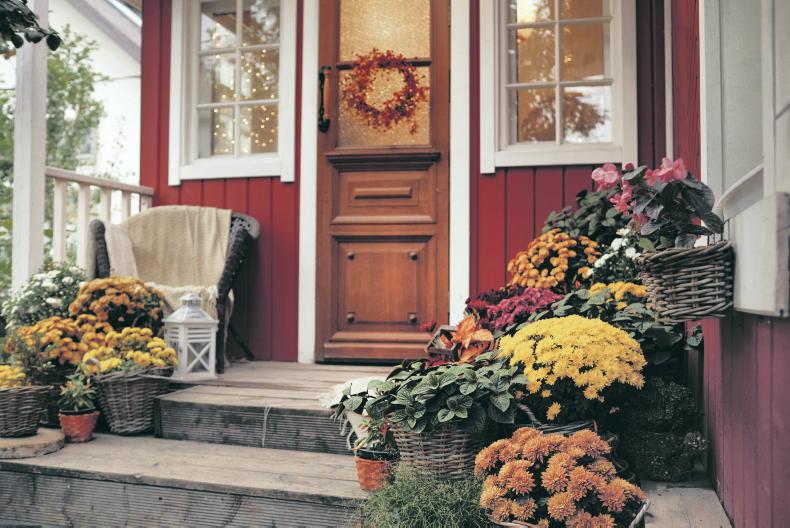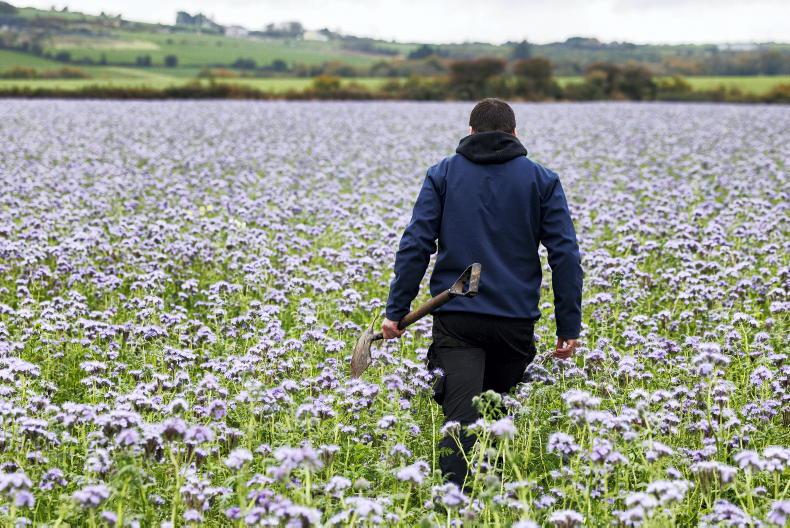In a year when losses due to clematis wilt were far more widespread than usual after a mild spring, it might be time to consider using the Italian clematis to a much greater extent.
There are quite a few kinds and more have become available due to renewed interest in the group.
The wild species has small flowers, carried singly or in small clusters, with four petals and a cross shape, and slightly drooping or bell-shaped.
Most of the varieties have aspects of this structure, the airy lightness of stems and the shape of flowers. The colours are purple, violet, red and white, and some flowers can have six petals.
‘Kermesina’ is a real beauty, vigorous with rich crimson blooms. Each broad petal is blotched with white at the base. The first flowers can be streaked with green and twisted, a quality shared with some other hybrids.

Clematis viticella 'Venosa Violacea'.
Another red variety, ‘Madame Julia Correvon’ was bred in France, and has dark buds that open to produce twisted wine-red flowers with narrow petals that roll back, giving it a jaunty look. Its prominent yellow stamens are notable and it carries some flowers with a fuller six-petalled shape, flowering from July.
‘Etoile Violette’ is another French variety from the late 19th century when there was a vogue for these varieties in that country. This can start to flower in June and continues to early autumn with rich deep violet flowers, mostly with six petals and quite full and rounded.
Also from France, ‘Royal Velours’ is not quite purple, not quite red, a wine colour and the petals has a velvety quality.
An even older variety, ‘Purpurea Plena Elegans’ has small double flowers almost like small roses in a washed-out deep red colour. It flowers in a big flush in mid-summer.
‘Betty Corning’ produces masses of silvery pinkish mauve flowers that are scented, bell-shaped on long stems from mid-June onwards. The four-petalled flowers open a little darker and fade slightly.
‘Polish Spirit’ is a relatively new variety, less than thirty years old but has become widely popular for its nicely shaped rich violet blue flowers, often with six pointed petals, some flowers with four. It is free-flowering from mid-summer into autumn.
‘Alba Luxurians’ is one of the few white varieties and it has the unusual quality of producing some flowers with green tips to the petals or even wholly green petals on the first flowers.
Not as vigorous as some others. ‘Huldine’ is white and flowers in July and August. It has six petals and a rounded flower, up-facing and petals bent backwards.
‘Venosa Violacea’ has blue-purple flowers with white streaking at the centre of the petals, very beautiful and long flowering well into autumn.
‘Jackmanii’ is a popular variety of deep violet purple, its Viticella parentage evident in its sometimes four-petalled flowers.
‘Ville de Lyon’ has masses of bright red large rounded flowers in late summer. Any of these varieties can be planted now, into well-drained soil, ideally with plenty of leaf mould incorporated, the roots shaded by a shrub and allowance for the shoots to grow into the sunlight to flower.
The group flowers on shoots made in the same season, which means the entire top of the plant can be taken off in late winter or very early spring but it is not essential to prune at all and the plants can be left for years, and will not get too big.
Broad bean
chocolate spot
Chocolate spot of broad beans is a common disease most years. It is usually seen low down on the plant on the older leaves which tend to be slowest to dry out and it is a disease that likes damp air. This year saw severe attacks right up the plant to the very top and the attack was so intense that the leaves withered on some plants, destroyed by hundreds of small brown spots which can link up.

Chocolate spot on broad bean foliage.
When there is significant leaf loss, the formation of pods is affected and yields reduced.
There is no real cure, too late when it is seen, but try to keep the foliage dry by planting a bit further apart in a less-sheltered place, though not so windy as to knock the stems over. The dwarf varieties seem to be more prone to the problem because they are close to the soil and their foliage is more dense. It is likely to be seed borne, so a quick dip in mild bleach solution might be no harm. Compost well all affected foliage or dig it down.
>> This week
Flowers
Spring bulbs are now available everywhere and should be planted as soon as possible. There are great deals on large packs and bags of bulbs. A final liquid feed can be given to hanging baskets and other containers to help them last their final few weeks.
Fruit, vegetables and herbs
Spring cabbage plants should be set out during the next two weeks or so, or right away if the plants are big enough, and they have grown well in recent weeks. Remove old vegetable crops as soon as they are finished and do not allow weeds to go to seed. Prepare for planting new fruit trees and bushes.
Trees, shrubs and roses
Prepare areas of ground for planting trees and shrubs during the autumn by killing off all existing vegetation with Roundup or similar. Prune rambler roses that have finished flowering and they will flower better next year. Check that young trees are securely staked if they need it.
Lawns
Continue mowing and use an autumn lawn fertiliser (lower in nitrogen and higher in potash and phosphorus). This will set up the lawn nicely for the rest of the autumn and winter. It is the ideal time to sow a new lawn. Apply lawn weedkillers if the weather is warm enough and soil temperature are high.
Greenhouse and house plants
Tidy up the greenhouse now and do not over-water or splash water about. Continue to side-shoot tomatoes and cucumbers. Allow only existing fruit to develop on these. Pot up any cuttings taken during the summer that have rooted well, but if freshly rooted, leave until spring.
In a year when losses due to clematis wilt were far more widespread than usual after a mild spring, it might be time to consider using the Italian clematis to a much greater extent.
There are quite a few kinds and more have become available due to renewed interest in the group.
The wild species has small flowers, carried singly or in small clusters, with four petals and a cross shape, and slightly drooping or bell-shaped.
Most of the varieties have aspects of this structure, the airy lightness of stems and the shape of flowers. The colours are purple, violet, red and white, and some flowers can have six petals.
‘Kermesina’ is a real beauty, vigorous with rich crimson blooms. Each broad petal is blotched with white at the base. The first flowers can be streaked with green and twisted, a quality shared with some other hybrids.

Clematis viticella 'Venosa Violacea'.
Another red variety, ‘Madame Julia Correvon’ was bred in France, and has dark buds that open to produce twisted wine-red flowers with narrow petals that roll back, giving it a jaunty look. Its prominent yellow stamens are notable and it carries some flowers with a fuller six-petalled shape, flowering from July.
‘Etoile Violette’ is another French variety from the late 19th century when there was a vogue for these varieties in that country. This can start to flower in June and continues to early autumn with rich deep violet flowers, mostly with six petals and quite full and rounded.
Also from France, ‘Royal Velours’ is not quite purple, not quite red, a wine colour and the petals has a velvety quality.
An even older variety, ‘Purpurea Plena Elegans’ has small double flowers almost like small roses in a washed-out deep red colour. It flowers in a big flush in mid-summer.
‘Betty Corning’ produces masses of silvery pinkish mauve flowers that are scented, bell-shaped on long stems from mid-June onwards. The four-petalled flowers open a little darker and fade slightly.
‘Polish Spirit’ is a relatively new variety, less than thirty years old but has become widely popular for its nicely shaped rich violet blue flowers, often with six pointed petals, some flowers with four. It is free-flowering from mid-summer into autumn.
‘Alba Luxurians’ is one of the few white varieties and it has the unusual quality of producing some flowers with green tips to the petals or even wholly green petals on the first flowers.
Not as vigorous as some others. ‘Huldine’ is white and flowers in July and August. It has six petals and a rounded flower, up-facing and petals bent backwards.
‘Venosa Violacea’ has blue-purple flowers with white streaking at the centre of the petals, very beautiful and long flowering well into autumn.
‘Jackmanii’ is a popular variety of deep violet purple, its Viticella parentage evident in its sometimes four-petalled flowers.
‘Ville de Lyon’ has masses of bright red large rounded flowers in late summer. Any of these varieties can be planted now, into well-drained soil, ideally with plenty of leaf mould incorporated, the roots shaded by a shrub and allowance for the shoots to grow into the sunlight to flower.
The group flowers on shoots made in the same season, which means the entire top of the plant can be taken off in late winter or very early spring but it is not essential to prune at all and the plants can be left for years, and will not get too big.
Broad bean
chocolate spot
Chocolate spot of broad beans is a common disease most years. It is usually seen low down on the plant on the older leaves which tend to be slowest to dry out and it is a disease that likes damp air. This year saw severe attacks right up the plant to the very top and the attack was so intense that the leaves withered on some plants, destroyed by hundreds of small brown spots which can link up.

Chocolate spot on broad bean foliage.
When there is significant leaf loss, the formation of pods is affected and yields reduced.
There is no real cure, too late when it is seen, but try to keep the foliage dry by planting a bit further apart in a less-sheltered place, though not so windy as to knock the stems over. The dwarf varieties seem to be more prone to the problem because they are close to the soil and their foliage is more dense. It is likely to be seed borne, so a quick dip in mild bleach solution might be no harm. Compost well all affected foliage or dig it down.
>> This week
Flowers
Spring bulbs are now available everywhere and should be planted as soon as possible. There are great deals on large packs and bags of bulbs. A final liquid feed can be given to hanging baskets and other containers to help them last their final few weeks.
Fruit, vegetables and herbs
Spring cabbage plants should be set out during the next two weeks or so, or right away if the plants are big enough, and they have grown well in recent weeks. Remove old vegetable crops as soon as they are finished and do not allow weeds to go to seed. Prepare for planting new fruit trees and bushes.
Trees, shrubs and roses
Prepare areas of ground for planting trees and shrubs during the autumn by killing off all existing vegetation with Roundup or similar. Prune rambler roses that have finished flowering and they will flower better next year. Check that young trees are securely staked if they need it.
Lawns
Continue mowing and use an autumn lawn fertiliser (lower in nitrogen and higher in potash and phosphorus). This will set up the lawn nicely for the rest of the autumn and winter. It is the ideal time to sow a new lawn. Apply lawn weedkillers if the weather is warm enough and soil temperature are high.
Greenhouse and house plants
Tidy up the greenhouse now and do not over-water or splash water about. Continue to side-shoot tomatoes and cucumbers. Allow only existing fruit to develop on these. Pot up any cuttings taken during the summer that have rooted well, but if freshly rooted, leave until spring.











SHARING OPTIONS